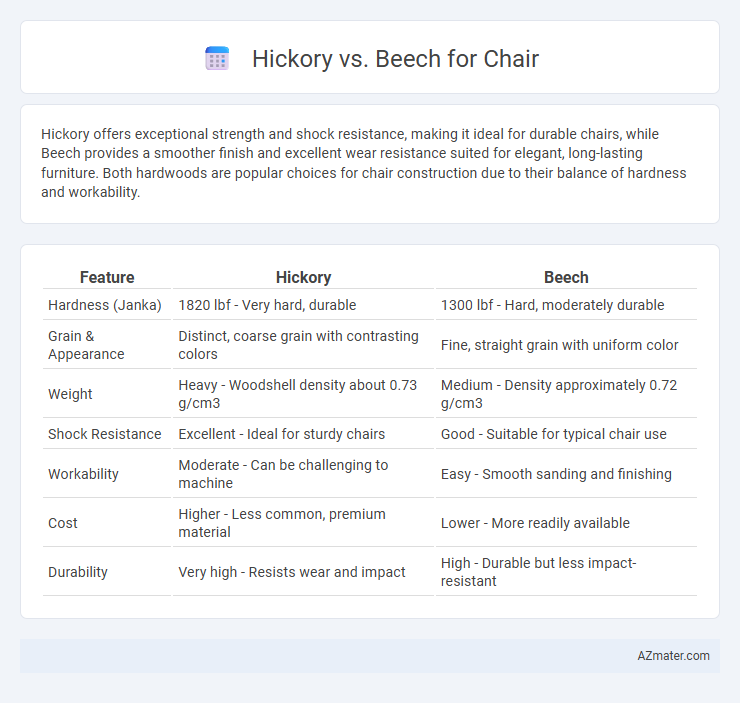Hickory offers exceptional strength and shock resistance, making it ideal for durable chairs, while Beech provides a smoother finish and excellent wear resistance suited for elegant, long-lasting furniture. Both hardwoods are popular choices for chair construction due to their balance of hardness and workability.
Table of Comparison
| Feature | Hickory | Beech |
|---|---|---|
| Hardness (Janka) | 1820 lbf - Very hard, durable | 1300 lbf - Hard, moderately durable |
| Grain & Appearance | Distinct, coarse grain with contrasting colors | Fine, straight grain with uniform color |
| Weight | Heavy - Woodshell density about 0.73 g/cm3 | Medium - Density approximately 0.72 g/cm3 |
| Shock Resistance | Excellent - Ideal for sturdy chairs | Good - Suitable for typical chair use |
| Workability | Moderate - Can be challenging to machine | Easy - Smooth sanding and finishing |
| Cost | Higher - Less common, premium material | Lower - More readily available |
| Durability | Very high - Resists wear and impact | High - Durable but less impact-resistant |
Introduction: Hickory vs Beech for Chair Making
Hickory and beech are popular hardwood choices for chair making due to their strength and durability. Hickory offers exceptional shock resistance and a striking grain pattern, making it ideal for rustic or heavy-use furniture. Beech provides a fine, uniform texture and excellent workability, favored for smooth finishes and traditional chair designs.
Wood Characteristics: Hickory Compared to Beech
Hickory wood is known for its exceptional strength and shock resistance, making it ideal for durable chair construction, whereas Beech offers a fine, tight grain with a smooth texture that is easier to shape and finish. Hickory's natural toughness and rich color variations range from pale to reddish-brown, contrasting with Beech's consistent light cream to pinkish hue. While Hickory provides superior impact resistance, Beech wood excels in stability and uniformity, offering a balanced choice for comfortable and stylish chairs.
Durability and Strength Analysis
Hickory wood offers exceptional durability and strength, making it ideal for chair construction with a Janka hardness rating of approximately 1,820 psi, which resists dents and wear effectively. Beech wood, while also strong with a Janka hardness of around 1,300 psi, is slightly less dense and may show wear faster under heavy use but provides excellent shock resistance and flexibility. Both woods are suitable for chairs, but hickory outperforms beech in terms of long-term durability and load-bearing capacity.
Workability and Ease of Shaping
Hickory offers superior workability and ease of shaping due to its dense yet flexible grain, making it ideal for sturdy chair frames that require intricate bends. Beech wood is also highly workable with a fine, even texture, providing smooth shaping and a clean finish, especially preferred for detailed chair components like spindles and legs. Both woods respond well to steam bending and carving, but hickory's resilience makes it better suited for durable chairs that withstand heavy use.
Aesthetic Appeal: Grain and Color Differences
Hickory wood features a bold grain pattern with striking contrasts between its light sapwood and darker heartwood, creating a rustic and dynamic aesthetic ideal for statement chairs. Beech wood exhibits a fine, uniform grain with a pale, creamy color that offers a smooth, subtle elegance perfect for modern and minimalist chair designs. The natural color variation in hickory provides a more dramatic visual impact, while beech's consistent tone allows for versatile staining and finishing options.
Comfort and Weight Considerations
Hickory offers exceptional strength and durability, making chairs sturdy but relatively heavy, which may affect ease of movement and comfort over long periods. Beech wood, known for its fine grain and moderate hardness, provides a smoother surface and lighter weight, enhancing comfort and portability for chair designs. Weight considerations favor beech for seating furniture requiring frequent relocation, while hickory excels in applications demanding robust support and longevity.
Cost Comparison: Hickory vs Beech
Hickory chairs typically cost more than beech chairs due to hickory's greater density and durability, which contribute to higher material and manufacturing expenses. Beech is more affordable because it is widely available and easier to work with, making it a cost-effective option for budget-conscious buyers. The price difference can vary by region but generally, hickory chairs command a premium of 20-30% over beech counterparts.
Sustainability and Environmental Impact
Hickory and beech are both popular hardwood choices for chair manufacturing, with hickory known for its strength and durability, while beech offers a smooth finish and ease of shaping. Sustainability-wise, beech trees grow relatively quickly and are widely available, making them a more renewable option compared to slower-growing hickory, which may involve longer harvesting cycles and potential forest depletion risks. Beech wood production generally results in lower carbon emissions due to more efficient processing techniques, contributing to a reduced environmental footprint in chair manufacturing.
Best Uses and Recommended Chair Styles
Hickory, valued for its exceptional strength and shock resistance, is ideal for rustic, farmhouse, and traditional chair styles that require durability and a robust frame. Beech, with its fine grain and smooth texture, suits modern, Scandinavian, and bentwood chair designs where malleability and a refined finish are essential. Both hardwoods excel in crafting dining chairs and armchairs, but hickory's toughness complements high-traffic environments while beech offers elegance and ease of shaping for intricate details.
Conclusion: Choosing the Right Wood for Your Chair
Hickory offers exceptional strength and shock resistance, making it ideal for durable, long-lasting chairs designed to withstand heavy use. Beech provides a smooth finish and consistent grain, enhancing aesthetic appeal and comfort for indoor seating with a polished look. Selecting between hickory and beech depends on whether durability or refined appearance is the priority for your chair's intended use.

Infographic: Hickory vs Beech for Chair
 azmater.com
azmater.com